Vol. 11, No. 9 / Seafood and Full-Service Restaurants in the US and Gulf of Mexico Region
Abstract
In this issue, Dr. Posadas compiled and summarized the economic contributions of seafood restaurants in the entire U.S. and Gulf regional economies from 2011 to 2017. The trends in the number, wages, salaries, and earnings of workers and owners of full-service restaurants were presented from 2014 to 2020. The socioeconomic characteristics of workers and owners in 2016 and 2020 were compared. These long-term data on seafood and full-service restaurants illustrate the significance of the industry in the national and Gulf economies. The direct impacts of the global pandemic on full-service restaurants are presented in annual percent changes.
Keywords
Seafood restaurants; full-service restaurants; economic contributions; gross regional product; jobs and wages, salaries, and earnings; socioeconomic characteristics; workers and owners
Acknowledgment
This newsletter is a contribution of the Mississippi Agricultural and Forestry Experiment Station and the Mississippi State University Extension Service. This material is based upon work that is supported in part by the National Institute of Food and Agriculture, U.S. Department of Agriculture, Hatch project under accession number 081730 and NOAA (Office of Sea Grant, U.S. Dept. of Commerce, under Grant NA10OAR4170078, Mississippi Alabama Sea Grant Consortium).
Economic Contributions of Seafood Restaurants
An economic contribution measures the gross change in economic activity associated with an industry, event, or policy in an existing regional economy. This newsletter presents two types of economic contributions – employment or jobs and output or sales. The output or sales contributions are expressed in dollars for a specified year. Employment or jobs contributions are expressed in terms of a mix of both full-time and part-time employment.
During the past seven years, the annual sales contributions of seafood restaurants to the U.S. economy averaged $27 billion. The seafood restaurants created more than 520,000 jobs per year (Fig. 1). However, these data are over three years old. No recent updates are currently available from NOAA Fisheries.

The annual sales contributions of seafood restaurants to GOM regional economy averaged $3.1 billion. The seafood restaurants created more than 53,000 jobs per year in the GOM region (Fig. 2). There are no current updates since 2017.
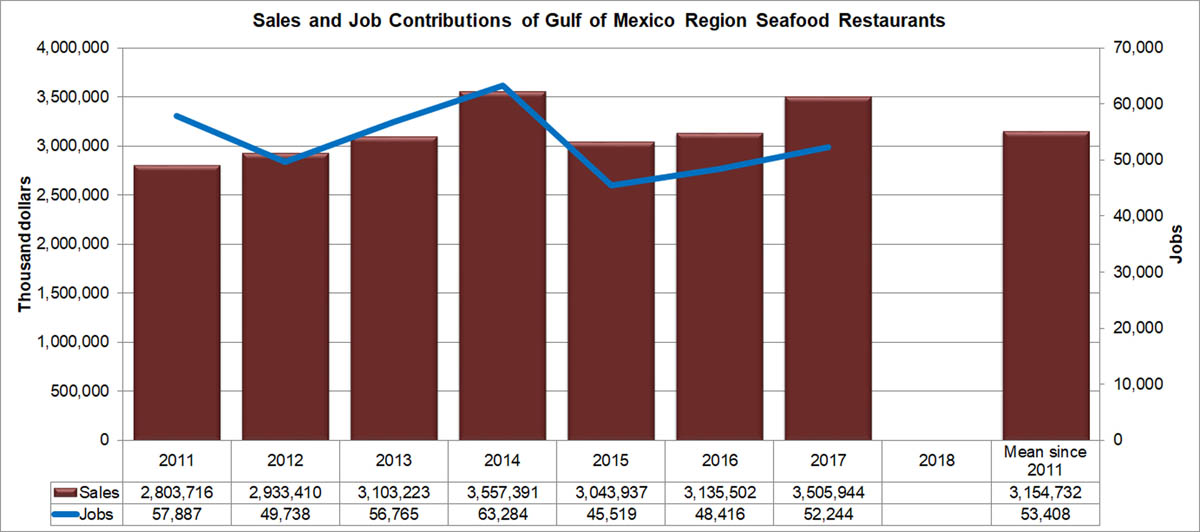
U.S. Full-Service Restaurants (FSR) Gross Regional Product
This U.S. FSR industry comprises establishments primarily engaged in providing food services to patrons who order and are served while seated (i.e., waiter/waitress service) and pay after eating. These establishments may provide this type of food service to patrons in combination with selling alcoholic beverages, providing carry-out services, or presenting live nontheatrical entertainment.
The gross regional product (GRP), also called regional gross domestic product (GDP), is the market value of all goods and services produced within a given area over a specific period and is a good measure of the size, income, and productivity of a regional economy (EMSI, 2021).
The GRP of FSR’s in the U.S. reached over $200 billion per year during recent years. However, the GRP of FSR’s in the U.S significantly declined in 2020 by 25 percent.
In the GOM region, the GRP of FSR’s averaged $34.6 billion per year or 19 percent of the U.S. during the past seven years. In 2020, the GRP of the FSR’s in the GOM region significantly fell by 17 percent.
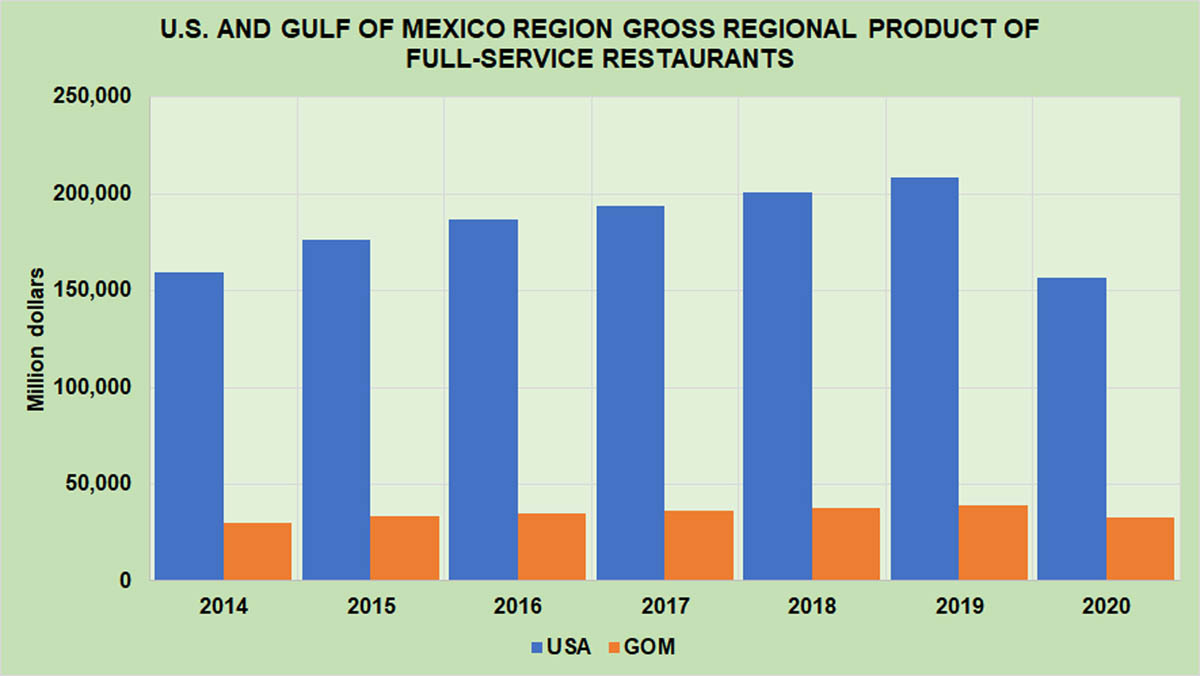
- The GRP of FSR’s in Alabama reached $2 billion per year during recent years.
- The GRP of FSR’s in Mississippi was moving toward $1 billion per year during recent years.
- The GRP of FSR’s in Louisiana exceeded $2 billion per year during recent years.
- However, during the global pandemic, significant declines in the GRPs were observed.
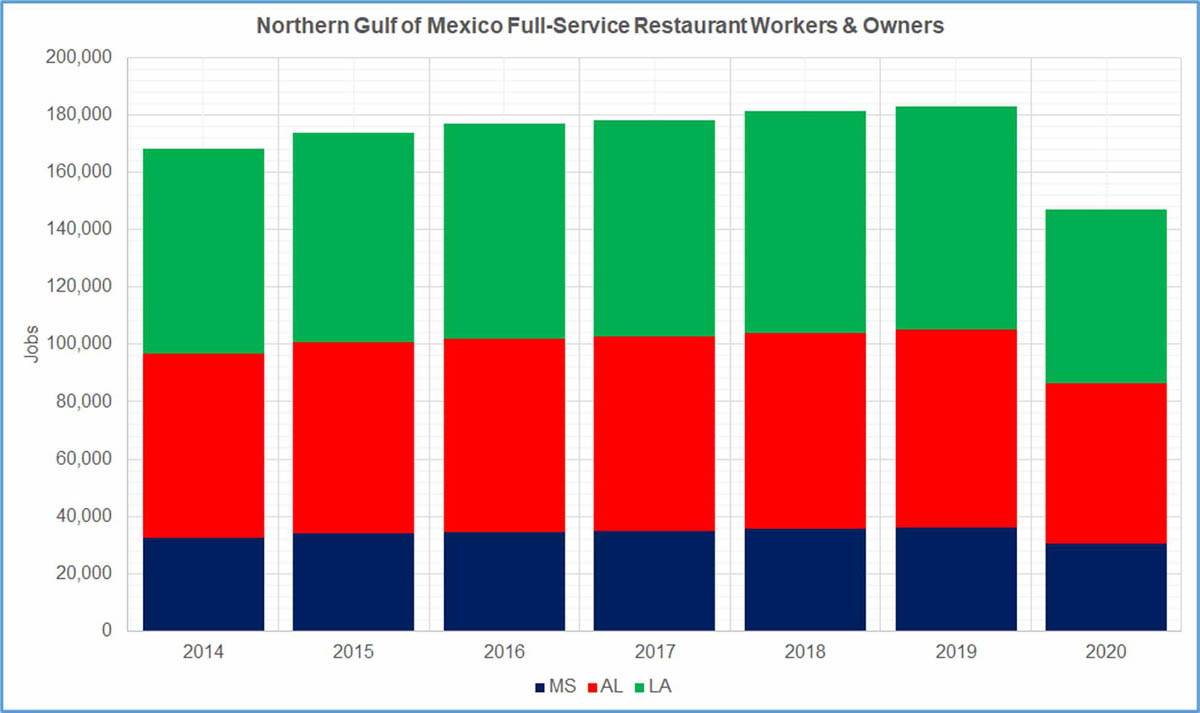
- The GRP of FSR’s in Alabama significantly declined in 2020 by 14 percent.
- In 2020, the GRP of the FSR’s in Mississippi significantly fell by 11 percent.
- The GRP of FSR’s in Louisiana significantly declined in 2020 by 20 percent.
Full-Service Restaurants’ (FSR) Employment And Wages, Salaries, And Earnings
FSR’s directly provided over 5.2 million jobs per year in the U.S. during the past seven years. About 26 percent of FSR jobs in the U.S. were lost due to the global pandemic in 2020.
The five GOM states (AL, FL, LA, MS, and TX) added 20 percent of the FSR jobs during the period. Approximately 19 percent of the FSR jobs in the GOM were lost in 2020 due to the global pandemic (Fig 5).
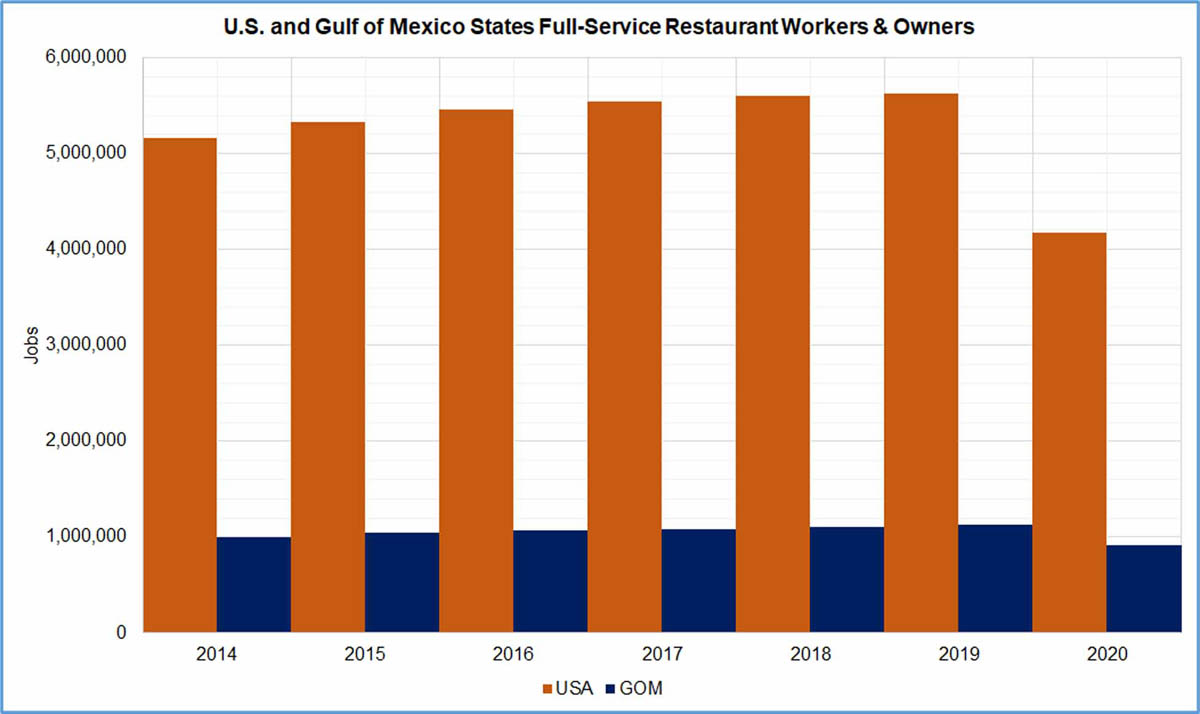
- FSR’s provided 65,000 jobs per year in the Alabama but lost 19 percent of these jobs in 2020.
- FSR’s created 34,000 jobs per year in the Mississippi but lost 15 percent of these jobs in 2020.
- FSR’s generated 73,000 jobs per year in the Louisiana but lost 22 percent of these jobs in 2020 (Fig. 6).

- The combined wages, salaries, and proprietor earnings of all workers and owners in the U.S. averaged more than $21,467 per person the past seven years (Fig. 7).
- The annual pay of workers and owners in the five Gulf of Mexico States averaged $21,383 per person or 99 percent of the national average.
- Mississippi added about 34,000 jobs per year during the past seven years with annual wages, salaries, and earnings about 80 percent of the national average.
- Alabama created about 65,000 jobs per year during the past seven years with annual wages, salaries, and earnings about 86 percent of the national average.
- Louisiana generated about 73,000 jobs per year during the past seven years with annual wages, salaries, and earnings about 92 percent of the national average.
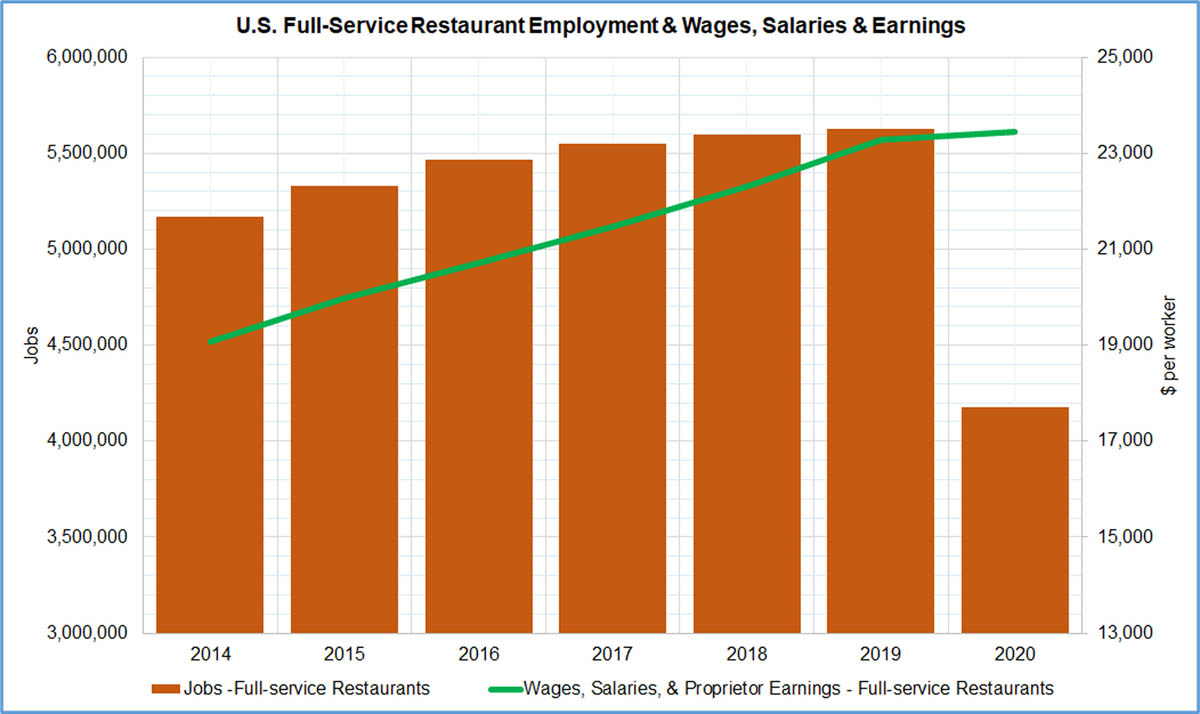
Industry Breakdown Of Full-Service Restaurants (FSR) Employees And Owners By Gender
The 2020 industrial overview released by EMSI (April 2021) showed that approximately 46.9 percent were males (Table 1). About 53.1 percent of the workers and owners were females.
In the Gulf States, 47.3 percent of the FSR workers and owners are males. While 52.7 percent of the FSR workers and owners are females.


The proportion of male workers and owners of FSR’s in the U.S. decreased from 47.4 to 46.9 percent from 2016 to 2020 (Fig. 8). There were relatively more women workers and owners of FSR’s in the U.S. in 2020 compared to 2016.
Industry Breakdown Of Full-Service Restaurants (FSR) Employees And Owners By Race Or Ethnicity
The 2020 industrial overview disseminated by EMSI (April 2021) also categorized the workers and owners by race or ethnicity (Table 2). Most of the FSR workers in the U.S. are White (55.7%), followed by Hispanic (20.4%), African American (13.3%), and Asian (7.4%). The rest are with two or more races (2.3%), Native Hawaiian (0.2%), and American Indian (0.6%).
In the Gulf States, relatively more Hispanic (27.6%) and African American (18.3%) workers and owners are involved in the FSR industry. Fewer White (46.4%) and Asian (5.5%) workers and owners are engaged in FSR’s in the Gulf States.
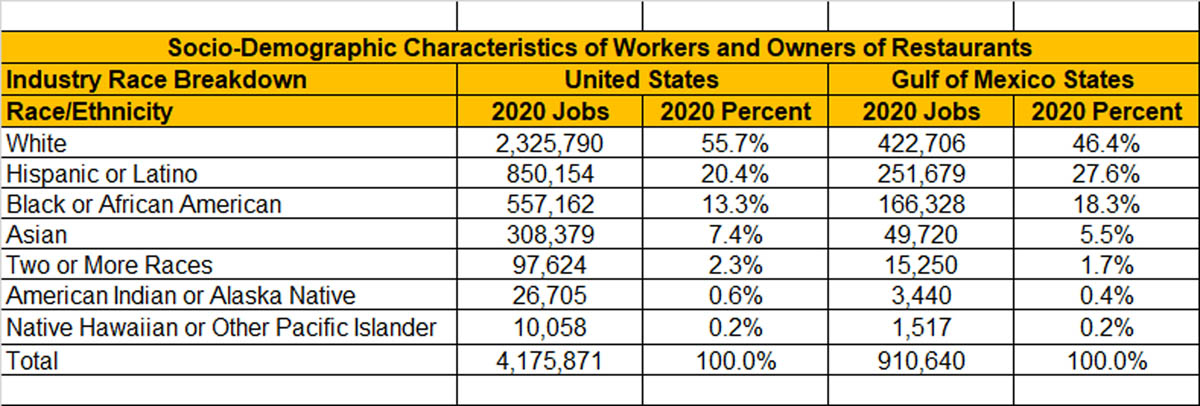
Relatively higher percentages of workers and owners in FSR’s in the U.S. were observed among Hispanic, African American, and Asian workers and owners in 2020 (Fig. 9). Lower proportion was detected among White workers and owners in FSR’s in the U.S. in 2020.
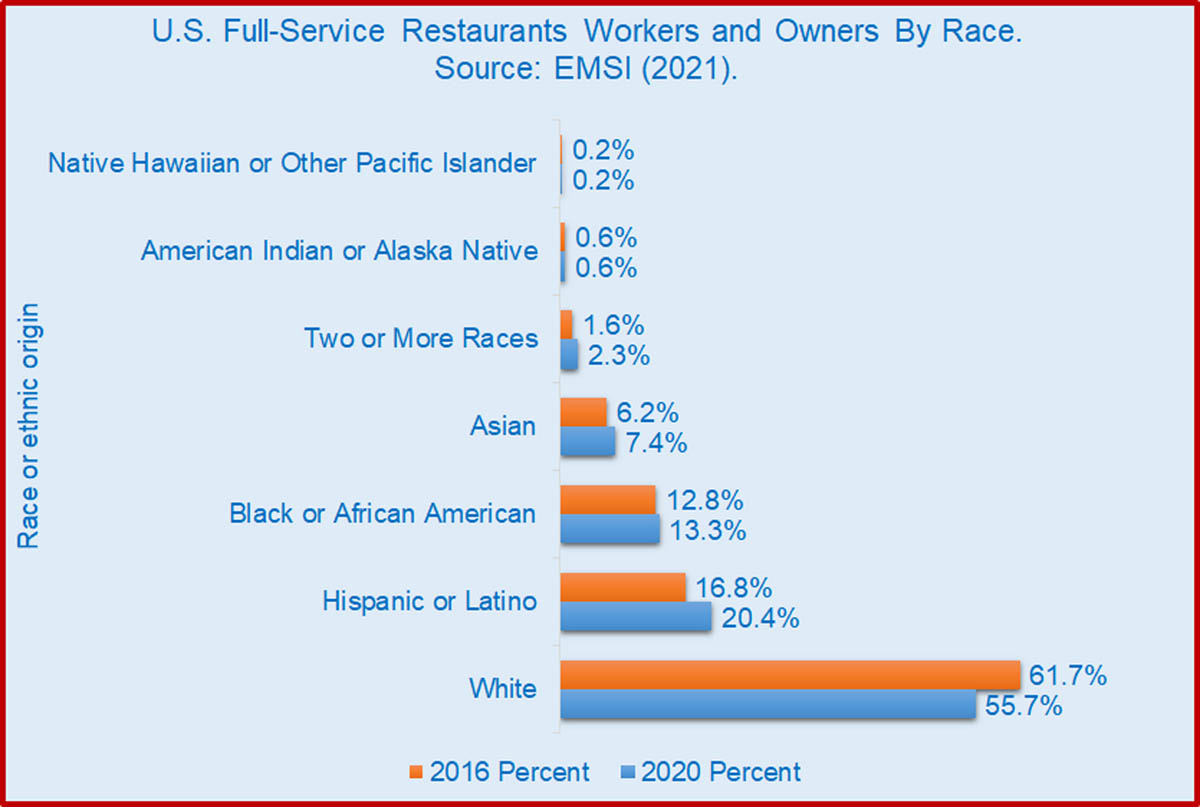
Industry Breakdown of Full-Service Restaurants (FSR) Employees And Owners By Age
The 2020 industrial overview published by EMSI (April 2021) also classified the workers and owners by age (Table 3).
- 4.4 percent of the U.S. FSR workers and owners are 65 + years old.
- 8.0 percent of the workers and owners were 55-64 years old.
- The 45-54 years old group added 11.6 percent.
- The 35-44 years old consisted of 16.1 percent.
- The 25-34 years old added 23.2 percent.
- 19-24 years old workers and owners consisted of 23 percent.
- The youngest employees and owners comprised the rest.
Workers and owners of FSR’s in the Gulf States are relatively older than the national average. U.S. and Gulf FSR workers and owners averaged 33.8 and 34.1 years old, respectively.


Relatively more 65 & above, 55-64, 35-44, and 14-18 years-old FSR workers and owners in the U.S. were reported in 2020. However, there was a decline among 45-54, 25-34, and 19-24 years-old FSR workers and owners in the U.S. in 2020.

Summary
1. The economic contributions of U.S. seafood restaurants from 2011 to 2017 averaged $27 billion in sales and 520,000 jobs.
2. The economic contributions of seafood restaurants in the Gulf of Mexico region from 2011 to 2017 averaged $3.1 billion in sales and 53,000 jobs.
3. The annual gross regional products of full-service restaurants in the U.S. recently reached over $200 billion but significantly fell by 25 percent in 2020.
4. The full-service restaurants in the U.S. provided over 5.5 million jobs in recent years but the global pandemic eliminated 26 percent in 2020.
5. The Covid-19 global pandemic caused significant reductions in sales, jobs and incomes of workers and owners in 2020 in the Gulf region and individual states.
My seafood and full-service restaurnts economics outreach
1. Posadas, B.C. 2021. Full-service Restaurants in the United States and the Gulf of Mexico Region. Miss. MarketMaker Newsletter, Vol. 11, No. 9.
2. Posadas, B.C. 2021. Full-service Restaurants in the United States and the Gulf of Mexico Region. Horticulture, Marine, and Disaster Economics Outreach. Miss. University Coastal Research and Extension Center, Biloxi, Miss.
3. Posadas, B.C. 2020. Mississippi Seafood Restaurants. Miss. State University Extension Service.
4. Posadas, B.C. 2019. Coastal Mississippi Restaurants. Miss. MarketMaker Newsletter, Vol. 9, No. 9.
5. Posadas, B.C. 2019. Economic Contributions of Seafood Markets and Restaurants in Mississippi and Alabama.
6. Posadas, B.C. 2017. Employment and Incomes in Restaurants and Other Eating Places. Miss. MarketMaker Newsletter. Vol. 7, No. 23.
7. Posadas, B.C. 2016. Know Your Local Seafood Restaurants! Miss. MarketMaker Newsletter, Vol. 6, Issue 9.
8. Posadas, B.C. 2016. What are the Seafood Products Served by Mississippi Restaurants? Miss. MarketMaker Newsletter, Vol. 6, Issue 15.
9. Posadas, B.C., A.K. Seymour and R.A. Posadas. 2016. Survey of Seafood Products Handled by Mississippi Restaurants. Miss. Agricultural and Forestry Experiment Station, Bulletin 1219.
10. Posadas, B.C., A.K. Seymour and R.A. Posadas. 2012. Survey of Seafood Products Handled by Mississippi Restaurants. Final report submitted to the Miss. Department of Marine Resources, Biloxi, Miss.
Suggested citation
Posadas, B.C. Seafood and Full-service Restaurants in the United States and Gulf of Mexico Region. Mississippi MarketMaker Newsletter, Vol. 11, No. 9. September 21, 2021.









